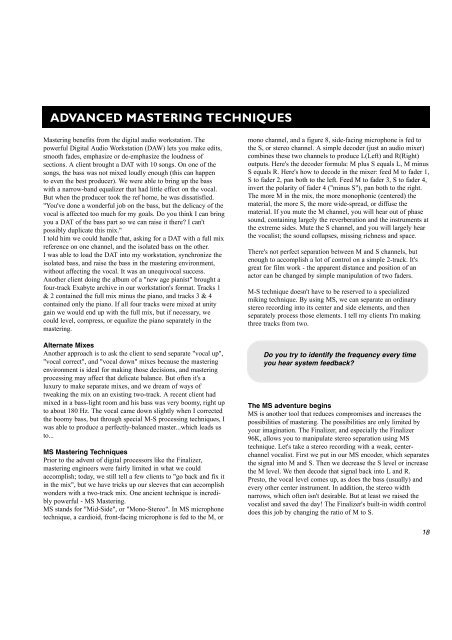2x4cdyD3b
2x4cdyD3b
2x4cdyD3b
You also want an ePaper? Increase the reach of your titles
YUMPU automatically turns print PDFs into web optimized ePapers that Google loves.
ADVANCED MASTERING TECHNIQUES<br />
Mastering benefits from the digital audio workstation. The<br />
powerful Digital Audio Workstation (DAW) lets you make edits,<br />
smooth fades, emphasize or de-emphasize the loudness of<br />
sections. A client brought a DAT with 10 songs. On one of the<br />
songs, the bass was not mixed loudly enough (this can happen<br />
to even the best producer). We were able to bring up the bass<br />
with a narrow-band equalizer that had little effect on the vocal.<br />
But when the producer took the ref home, he was dissatisfied.<br />
"You've done a wonderful job on the bass, but the delicacy of the<br />
vocal is affected too much for my goals. Do you think I can bring<br />
you a DAT of the bass part so we can raise it there? I can't<br />
possibly duplicate this mix."<br />
I told him we could handle that, asking for a DAT with a full mix<br />
reference on one channel, and the isolated bass on the other.<br />
I was able to load the DAT into my workstation, synchronize the<br />
isolated bass, and raise the bass in the mastering environment,<br />
without affecting the vocal. It was an unequivocal success.<br />
Another client doing the album of a "new age pianist" brought a<br />
four-track Exabyte archive in our workstation's format. Tracks 1<br />
& 2 contained the full mix minus the piano, and tracks 3 & 4<br />
contained only the piano. If all four tracks were mixed at unity<br />
gain we would end up with the full mix, but if necessary, we<br />
could level, compress, or equalize the piano separately in the<br />
mastering.<br />
Alternate Mixes<br />
Another approach is to ask the client to send separate "vocal up",<br />
"vocal correct", and "vocal down" mixes because the mastering<br />
environment is ideal for making those decisions, and mastering<br />
processing may affect that delicate balance. But often it's a<br />
luxury to make separate mixes, and we dream of ways of<br />
tweaking the mix on an existing two-track. A recent client had<br />
mixed in a bass-light room and his bass was very boomy, right up<br />
to about 180 Hz. The vocal came down slightly when I corrected<br />
the boomy bass, but through special M-S processing techniques, I<br />
was able to produce a perfectly-balanced master...which leads us<br />
to...<br />
MS Mastering Techniques<br />
Prior to the advent of digital processors like the Finalizer,<br />
mastering engineers were fairly limited in what we could<br />
accomplish; today, we still tell a few clients to "go back and fix it<br />
in the mix", but we have tricks up our sleeves that can accomplish<br />
wonders with a two-track mix. One ancient technique is incredibly<br />
powerful - MS Mastering.<br />
MS stands for "Mid-Side", or "Mono-Stereo". In MS microphone<br />
technique, a cardioid, front-facing microphone is fed to the M, or<br />
mono channel, and a figure 8, side-facing microphone is fed to<br />
the S, or stereo channel. A simple decoder (just an audio mixer)<br />
combines these two channels to produce L(Left) and R(Right)<br />
outputs. Here's the decoder formula: M plus S equals L, M minus<br />
S equals R. Here's how to decode in the mixer: feed M to fader 1,<br />
S to fader 2, pan both to the left. Feed M to fader 3, S to fader 4,<br />
invert the polarity of fader 4 ("minus S"), pan both to the right.<br />
The more M in the mix, the more monophonic (centered) the<br />
material, the more S, the more wide-spread, or diffuse the<br />
material. If you mute the M channel, you will hear out of phase<br />
sound, containing largely the reverberation and the instruments at<br />
the extreme sides. Mute the S channel, and you will largely hear<br />
the vocalist; the sound collapses, missing richness and space.<br />
There's not perfect separation between M and S channels, but<br />
enough to accomplish a lot of control on a simple 2-track. It's<br />
great for film work - the apparent distance and position of an<br />
actor can be changed by simple manipulation of two faders.<br />
M-S technique doesn't have to be reserved to a specialized<br />
miking technique. By using MS, we can separate an ordinary<br />
stereo recording into its center and side elements, and then<br />
separately process those elements. I tell my clients I'm making<br />
three tracks from two.<br />
Do you try to identify the frequency every time<br />
you hear system feedback?<br />
The MS adventure begins<br />
MS is another tool that reduces compromises and increases the<br />
possibilities of mastering. The possibilities are only limited by<br />
your imagination. The Finalizer, and especially the Finalizer<br />
96K, allows you to manipulate stereo separation using MS<br />
technique. Let's take a stereo recording with a weak, centerchannel<br />
vocalist. First we put in our MS encoder, which separates<br />
the signal into M and S. Then we decrease the S level or increase<br />
the M level. We then decode that signal back into L and R.<br />
Presto, the vocal level comes up, as does the bass (usually) and<br />
every other center instrument. In addition, the stereo width<br />
narrows, which often isn't desirable. But at least we raised the<br />
vocalist and saved the day! The Finalizer's built-in width control<br />
does this job by changing the ratio of M to S.<br />
18


